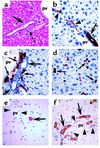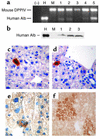HGF, SDF-1, and MMP-9 are involved in stress-induced human CD34+ stem cell recruitment to the liver
- PMID: 12865405
- PMCID: PMC164291
- DOI: 10.1172/JCI17902
HGF, SDF-1, and MMP-9 are involved in stress-induced human CD34+ stem cell recruitment to the liver
Abstract
Hematopoietic stem cells rarely contribute to hepatic regeneration, however, the mechanisms governing their homing to the liver, which is a crucial first step, are poorly understood. The chemokine stromal cell-derived factor-1 (SDF-1), which attracts human and murine progenitors, is expressed by liver bile duct epithelium. Neutralization of the SDF-1 receptor CXCR4 abolished homing and engraftment of the murine liver by human CD34+ hematopoietic progenitors, while local injection of human SDF-1 increased their homing. Engrafted human cells were localized in clusters surrounding the bile ducts, in close proximity to SDF-1-expressing epithelial cells, and differentiated into albumin-producing cells. Irradiation or inflammation increased SDF-1 levels and hepatic injury induced MMP-9 activity, leading to both increased CXCR4 expression and SDF-1-mediated recruitment of hematopoietic progenitors to the liver. Unexpectedly, HGF, which is increased following liver injury, promoted protrusion formation, CXCR4 upregulation, and SDF-1-mediated directional migration by human CD34+ progenitors, and synergized with stem cell factor. Thus, stress-induced signals, such as increased expression of SDF-1, MMP-9, and HGF, recruit human CD34+ progenitors with hematopoietic and/or hepatic-like potential to the liver of NOD/SCID mice. Our results suggest the potential of hematopoietic CD34+/CXCR4+cells to respond to stress signals from nonhematopoietic injured organs as an important mechanism for tissue targeting and repair.
Figures





References
-
- Alison MR, et al. Hepatocytes from non-hepatic adult stem cells. Nature. 2000;406:257. - PubMed
-
- Theise ND, et al. Liver from bone marrow in humans. Hepatology. 2000;32:11–16. - PubMed
-
- Korbling M, et al. Hepatocytes and epithelial cells of donor origin in recipients of peripheral-blood stem cells. N. Engl. J. Med. 2002;346:738–746. - PubMed
-
- Petersen BE, et al. Bone marrow as a potential source of hepatic oval cells. Science. 1999;284:1168–1170. - PubMed
-
- Theise ND, et al. Derivation of hepatocytes from bone marrow cells in mice after radiation-induced myeloablation. Hepatology. 2000;31:235–240. - PubMed
Publication types
MeSH terms
Substances
Grants and funding
LinkOut - more resources
Full Text Sources
Other Literature Sources
Medical
Miscellaneous

